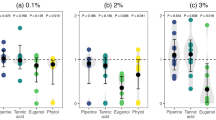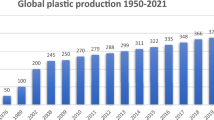Abstract
We collected and quantified both synthetic and natural Oriental fruit moth [Grapholitha molesta (Busck)] sex pheromone components in 250-ml round-bottom flasks by hexane rinsing of compounds adsorbed on the glass walls. This simple procedure collected 100% of the pheromone evaporated inside the flask and was useful for quantifying both nanogram and microgram amounts of emitted pheromone. Emission rates of (Z)-8-dodecenyl acetate from 1000, 100, and 10 μg-loaded rubber septa were 219, 12, and 1.2 ng/hr, respectively.G. molesta females emitted this component at 3.2 ng/hr, close to the emission rate from a 10 μg-loaded septum, which evokes “long-range” and “close-range” behaviors in the male. The corresponding alcohol, (Z)-8-dodecenyl alcohol, was emitted from rubber septa ca. 3 times faster than the acetate.
Similar content being viewed by others
References
Baker, T.C., andCardé, R.T. 1979a. Endogenous and exogenous factors affecting female calling and male sex pheromone response inGrapholitha molesta (Busck).J. Insect Physiol. 25:943–950.
Baker, T.C., andCardé, R.T. 1979b. Analysis of pheromone-mediated behaviors in maleGrapholitha molesta, the Oriental fruit moth (Lepidoptera: Tortricidae).Environ. Entomol. 8:956–968.
Brady, U.E., andSmithwick, E.B. 1968. Production and release of sex attractant by the female Indian meal moth,Plodia interpunctella.Ann. Entomol. Soc. Am. 61:1260–1265.
Brooks, T.W., Ashare, E., andSwenson, D.W. 1977. Hollow fibers as controlled release devices, pp. 111–126,in J.C. Arthur, Jr., (ed.). Textile and Paper Chemistry and Technology, ACS Symposium Series 49. American Chemical Society, Washington, D.C.
Browne, L., Birch, M.C., andWood, D.L. 1974. Novel trapping and delivery system for air-borne insect pheromones.J. Insect Physiol. 20:183–193.
Butler, L.I., andMcDonough, L.M. 1979. Insect sex pheromones: evaporation rates of acetates from natural rubber septa.J. Chem. Ecol. 5:825–837.
Byrne, K.J., Gore, W.E., Pearce, G.T., andSilverstein, R.M. 1975. Porapak-Q collection of airborne organic compounds serving as models for insect pheromones.J. Chem. Ecol. 1:1–9.
Cardé, A.M., Baker, T.C., andCardé, R.T. 1979. Identification of a four component sex pheromone of the Oriental fruit moth,Grapholitha molesta (Lepidoptera: Torticidae).J. Chem. Ecol. 5:423–427.
Cross, J.H., Byler, R.C., Cassidy, R.F., Jr., Silverstein, R.M., Greenblatt, R.E., Burkholder, W.E., Levinson, A.R., andLevinson, H.Z. 1976. Porapak-Q collection of pheromone components and isolation of (Z)- and (E)-14-methyl-8-hexadecenal, sex pheromone components of four species ofTrogoderma (Coleoptera: Dermestidae).J. Chem. Ecol. 2:457–468.
Hill, A.S., Cardé, R.T., Kido, H., andRoelofs, W.L. 1975. Sex pheromone of the orange tortrix moth,Argyrotaenia cilrana (Lepidoptera: Tortricidae).J. Chem. Ecol. 1:215–224.
Keller, J.C., Mitchell, E.B., McKibben, G., andDavich, T.B. 1964. A sex attractant for female boll weevils from males.J. Econ. Entomol. 57:609–610.
Kuhr, R.J., Comeau, A., andRoelofs, W.L. 1972. Measuring release rates of pheromone analogues and synergists from polyethylene caps.Environ. Entomol. 1:625–627.
Maitlen, J.C., McDonough, L.M., Moffitt, H.R., andGeorge, D.A. 1976. Codling moth sex pheromone: Baits for mass trapping and population survey.Environ. Entomol. 5:199–202.
Roller, H., Biemann, K., Bjerke, J.S., Norgard, D.W., andMcShan, W.H. 1968. Sex pheromones of pyralid moths. I. Isolation and identification of the sex attractant ofGalleria mellonella (greater wax moth).Acta. Entomol. Bohemoslov. 65:208–211.
Sanders, C.J., andWeatherston, J. 1976. Sex pheromone of the eastern spruce budworm (Lepidoptera: Tortricidae): Optimum blend oftrans-andcis-11-tetradecenal.Can. Entomol. 108:1285–1290.
Vick, K.W., Coffelt, J.A., andSullivan, M.A. 1978. Disruption of pheromone communication in the Angoumois grain moth with synthetic female sex pheromone.Environ. Entomol. 7:528–531.
Weatherston, J., Roelofs, W., Comeau, A., andSanders, C.J. 1971. Studies of physiologically active arthropod secretions. X. Sex pheromone of the eastern spruce budworm,Choristoneura fumiferana (Lepidoptera: Tortricidae).Can. Entomol. 103:1741–1747.
Author information
Authors and Affiliations
Additional information
Lepidoptera: Tortricidae.
Paper of the Michigan State Agricultural Experiment Station.
Rights and permissions
About this article
Cite this article
Baker, T.C., Cardé, R.T. & Miller, J.R. Oriental fruit moth pheromone component emission rates measured after collection by glass-surface adsorption. J Chem Ecol 6, 749–758 (1980). https://doi.org/10.1007/BF00990399
Received:
Revised:
Issue Date:
DOI: https://doi.org/10.1007/BF00990399




